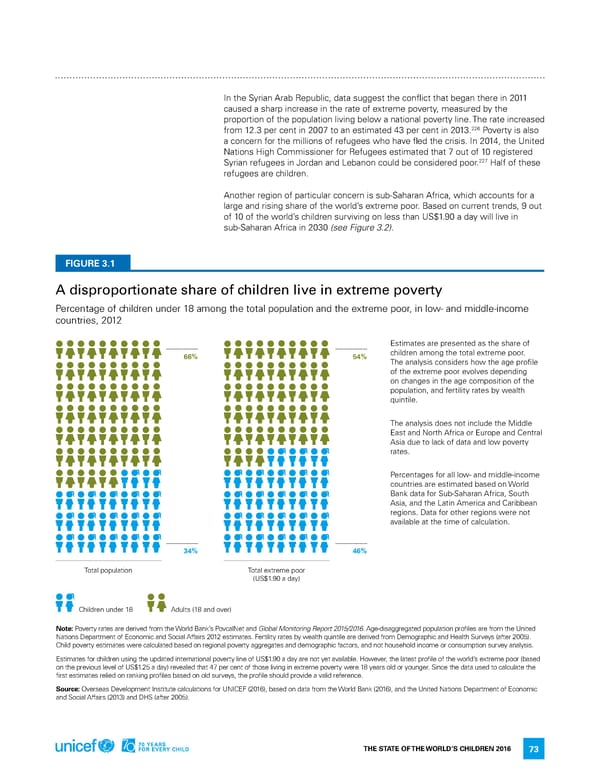in the Syrian arab republic, data suggest the conflict that began there in 2011 caused a sharp increase in the rate of extreme poverty, measured by the proportion of the population living below a national poverty line. The rate increased 226 from 12.3 per cent in 2007 to an estimated 43 per cent in 2013. Poverty is also a concern for the millions of refugees who have fled the crisis. in 2014, the United nations high Commissioner for refugees estimated that 7 out of 10 registered 227 Syrian refugees in Jordan and lebanon could be considered poor. half of these refugees are children. another region of particular concern is sub-Saharan africa, which accounts for a large and rising share of the world’s extreme poor. Based on current trends, 9 out of 10 of the world’s children surviving on less than US$1.90 a day will live in sub-Saharan africa in 2030 (see Figure 3.2). FIGURE 3.1 A disproportionate share of children live in extreme poverty Percentage of children under 18 among the total population and the extreme poor, in low- and middle-income countries, 2012 estimates are presented as the share of 66% 54% children among the total extreme poor. The analysis considers how the age profile of the extreme poor evolves depending on changes in the age composition of the population, and fertility rates by wealth quintile. The analysis does not include the Middle east and north africa or europe and Central asia due to lack of data and low poverty rates. Percentages for all low- and middle-income countries are estimated based on World Bank data for Sub-Saharan africa, South asia, and the latin america and Caribbean regions. data for other regions were not available at the time of calculation. 34% 46% Total population Total extreme poor (US$1.90 a day) Children under 18 adults (18 and over) Note: Poverty rates are derived from the World Bank’s Povcalnet and Global Monitoring Report 2015/2016. age-disaggregated population profiles are from the United nations department of economic and Social affairs 2012 estimates. fertility rates by wealth quintile are derived from demographic and health Surveys (after 2005). Child poverty estimates were calculated based on regional poverty aggregates and demographic factors, and not household income or consumption survey analysis. estimates for children using the updated international poverty line of US$1.90 a day are not yet available. however, the latest profile of the world’s extreme poor (based on the previous level of US$1.25 a day) revealed that 47 per cent of those living in extreme poverty were 18 years old or younger. Since the data used to calculate the first estimates relied on ranking profiles based on old surveys, the profile should provide a valid reference. Source: overseas development institute calculations for UniCef (2016), based on data from the World Bank (2016), and the United nations department of economic and Social affairs (2013) and dhS (after 2005). The STaTe of The World’S Children 2016 73
 70 Years for Every Child Page 89 Page 91
70 Years for Every Child Page 89 Page 91